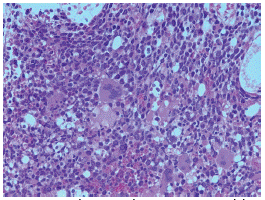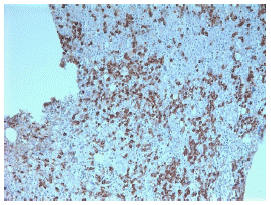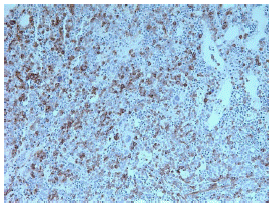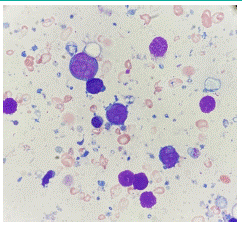
Case Report
Ann Hematol Onco. 2023; 10(4): 1433.
Leukemic Transformation of Longstanding Essential Thrombocythemia
Weir SJ¹*; Talari MP²; Nakhoul I³
¹Medical Student, Edward via College of Osteopathic Medicine, USA
²Department of Internal Medicine, Johnston Memorial Hospital, USA
³Department of Hematology and Oncology, Ballad Health Cancer Center, USA
*Corresponding author: Seth Weir Medical Student, Edward via College of Osteopathic Medicine, USA. Email: sweir@vt.vcom.edu
Received: June 26, 2023 Accepted: July 22, 2023 Published: July 29, 2023
Abstract
Acute Myeloid Leukemia (AML) represents only 1% of all cancers, despite being the most frequent type of leukemia [1]. Multiple genetic pathways are associated with AML, causing various changes in genetic transcription, apoptosis, chromatin remodeling, and protein levels. One such pathway, the JAK-STAT pathway, governs cellular proliferation, differentiation, and apoptosis, and is linked to both AML and myeloproliferative neoplasms due to mutations [2]. The JAK V617F mutation is the most common mutation in this pathway, occurring in about 50% of Essential Thrombocythemia (ET) patients, as described in this report [2]. While rare, transformation of Essential Thrombocythemia (ET) to AML occurs in 1-4% of cases [3]. This report presents a case of AML in a 76-year-old male with a medical history of ET. Following an abnormal peripheral blood smear, bone marrow biopsy confirmed the diagnosis. The current report aims to emphasize the significance of regular screening and monitoring for patients with long-standing Essential Thrombocythemia (ET), especially those under suppressive therapy. The transformation of ET to acute leukemia is associated with an unfavorable prognosis, underscoring the importance of early diagnosis. Therefore, this case serves to draw attention to the criticality of timely intervention through routine follow-up to achieve optimal outcomes for patients with ET.
Keywords: Acute Myeloid Leukemia; AML; ET; Essential thrombocythemia; Leukemic transformation
Case Presentation
This case describes a 76-year-old male with a past medical history of hypertension, Gastroesophageal Reflux Disease (GERD), vitamin B12 deficiency, and Essential Thrombocythemia (ET) for the past 19 years. The patient had an initial platelet count of 1143 K/uL and was tested for the JAK V617F mutation 8 years ago, when it was detected. The patient's ET was managed with Hydrea 500 mg BID for 13 years with a target platelet count of less than 600,000 K/uL. However, the patient had to decrease his Hydrea to 500 mg QD due to worsening anemia. On presentation to the oncology clinic, the patient's CBC showed low white blood cell counts (2.4 K/uL), low hemoglobin (8.7 g/dL), low hematocrit (26.3%), and a platelet count of 267 K/uL. The patient was found to have blast of 0.34 K/uL on manual differential. A Peripheral Blood Smear (PBS) was performed to further workup the patient's anemia, and it showed 5% blast-like cells, marked anisopoikilocytosis with dacrocytes and schistocytes, and no rouleaux formations.
Bone marrow biopsy was done, and it demonstrated increased blast-like cells (32.6%) with the cells of interest being 2-3x the size of normal red blood cells. Cytoplasmic granules were noted, and the cells were CD34 positive in 25-30%, with those that were positive expressing myeloperoxidase. The cells were negative for CD79a, cCD3, and TdT. Cells were TP 53 positive, IDH1 negative, IDH2 negative, and NPM1 negative. FLT3 mutation was not detected. Chromosomal analysis indicated an abnormal karyotype of: 62~65<3n>,XYY,-3,-5,add l(6)(q21),-7,+8,-12,-13,-15,-16,-17,-17,+18, add (19) (q13.3),-20,+22,+mar[cp17]/46,XY [3]. The bone marrow biopsy result was consistent with transformation of ET into Acute Myeloid Leukemia (AML) in Figure 1-4.

Figure 1: Bone marrow biopsy demonstrating blast cells with atypical megakaryocytes.

Figure 2: Bone marrow biopsy slide with MPO staining.

Figure 3: Bone marrow biopsy slide with CD34 staining.

Figure 4: Bone marrow biopsy slide demonstrating atypical blast cells with abundant background platelets.
Hydrea was halted and the patient was offered three therapeutic paths for treatment: Azacitidine in combination with Venetoclax, supportive care with transfusions of blood products as needed, or referral for hospice care. He ultimately decided to forgo systemic therapy, and enter hospice care.
Discussion/Conclusion
Leukemic transformation in patients with Essential Thrombocythemia (ET) is a rare occurrence, and its identification can be challenging due to its subtle presentation. We present a case of a patient with a history of hypertension, GERD, vitamin B12 deficiency, and ET who had been managed with hydroxyurea for several years. The patient presented to the oncology clinic for routine follow-up of ET and fatigue. The finding of blast cells on manual differential prompted PBS and bone marrow biopsy which led to the identification of leukemic transformation.
AML is not a unique cancer in this patient's age population, but leukemic transformation in ET is rare. Interestingly, the therapy used in our patient, hydroxyurea, is not associated with as increased of a risk of AML unlike other therapies for ET [2]. Although this patient did not present with signs and symptoms of leukemia, early identification of pancytopenia with resistance to correction, further strengthened the likelihood that there was leukemia transformation, and that the bone marrow suppression was not due to hydroxyurea.
Male gender is associated with an increase in overall survival of patients with ET, and increased time of disease is associated with a higher incidence of transformation to AML, so this could have contributed to our patient's transformation [4]. Intriguingly, the patient attempted to switch to anagrelide for maintenance suppression of ET, however, he was unable to tolerate due to diarrhea. Anagrelide as a sole agent without other cytotoxic therapies has not been associated with leukemic transformation. Anagrelide is able to achieve platelet control in 75% of patients and lacks association with leukemic transformation though it’s use is limited due to acquired idiopathic cardiomyopathy and post-ET myelofibrosis. Studies have also not shown that treatment with anagrelide have increased survival [5].
This case poses the importance of classifying the risk for leukemic transformation that patients with ET have by stratifying the mutations present. In this case, the patient had the JAK V617F mutation, which is associated with more complex cases in those who transformed into leukemia, with other driver mutations present more frequently [6]. Further classifying the molecular profile in these cases could help to stratify treatment strategies and guide the clinical course of the patient [6]. Besides harboring the JAK V617F mutation, bone marrow biopsy demonstrating fibrosis is consistent with a higher risk of leukemic transformation, as seen in this case [7].
Although AML is not a rare occurrence in patients who are greater than 60 years old, the acute onset in a patient with ET is a rare event, specifically those who have been treated with hydroxyurea only. This case provides insight into the presentation of someone with a leukemic transformation that was found incidentally and provides insight into how the symptoms may manifest. Hydroxyurea suppression for the maintenance of ET should be held off until symptoms manifest, specifically in younger patients, as it seems that the risk for leukemic transformation does not manifest until a patient has been treated for more than seven years. Perhaps screening for leukemic transformation with regular PBS in patients with longstanding ET would lead to earlier detection and a better prognosis. As the treatment for ET continues to evolve, hopefully a therapy with a lower incidence of leukemic transformation, like a JAK2 inhibitor, will arise, or those with ET associated with AML will have a better treatment option for the cancer.
References
- Key statistics for Acute myeloid leukemia (AML) 2023.
- Ding W, Li D, Zhuang C, Wei P, Mou W, et al. Essential thrombocythemia during treatment of acute myeloid leukemia with JAK2 V617F mutation: a case report of a CARE-compliant article. Medicine. 2018; 97: e11331.
- Bhatt VR. Leukemic transformation in essential thrombocythemia. Future Oncol. 2014; 10: 2593-602.
- Tefferi A, Barbui T. Polycythemia Vera and essential thrombocythemia: 2019 update on diagnosis, risk-stratification and management. Am J Hematol. 2019; 94: 133-43.
- Fruchtman SM, Petitt RM, Gilbert HS, Fiddler G, Lyne A, et al. Anagrelide: analysis of long-term efficacy, safety and leukemogenic potential in myeloproliferative disorders. Leuk Res. 2005; 29: 481-91.
- Alvarez-Larrán A, Senín A, Fernández-Rodríguez C, Pereira A, Arellano-Rodrigo E, et al. Impact of genotype on leukaemic transformation in polycythaemia vera and essential thrombocythaemia. Br J Haematol. 2017; 178: 764-71.
- Luque Paz D, Jouanneau-Courville R, Riou J, Ianotto JC, Boyer F, et al. Leukemic Evolution of Polycythemia Vera and essential thrombocythemia: genomic profiles predict time to transformation. Blood Adv. 2020; 4: 4887-97.